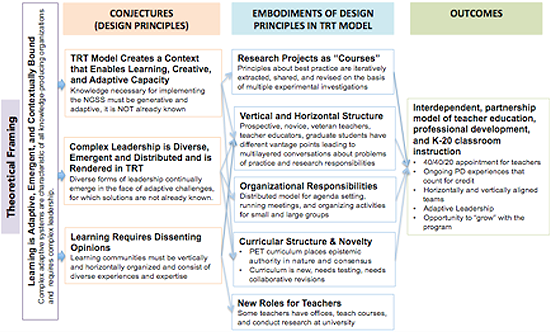Professor Valerie Otero
School of Education: Science Education
University of Colorado Boulder
Project Description:
Teacher Research Teams are small teams of veteran, novice, and prospective teachers who work together to investigate a “problem of practice” in their classrooms as they engage in the Scholarship of Teaching and Learning (SoTL). In academic year 2015-2016 I will teach a new three-credit course for Teacher Research Team (TRT) participants. This course will count towards teacher certification credit for CU Teach students or graduate-level credit for practicing teachers. TRTs have met regularly for the past two years with rigorous meeting agendas and activities. In 2015-2016, the TRT experience will be built into the CU Teach teacher certification program in the School of Education at CU Boulder.
My Scholarship of Teaching and Learning (SoTL) project will evaluate the extent to which the new TRT experiential learning course meets the Colorado Department of Education Teacher Quality Standards, which are also the course goals. These standards/goals are listed in the first column of table 1. All class participants will be responsible for turning in a research project plan with a theoretical framework by the end of Fall 2015. Since I will continue to work with these teachers in Spring 2016, each Team will also be responsible for turning in a publishable research paper that describes their study, findings, and its implications for practice. Table 1 also lists the following data sources for measuring each goal: (a) research products, (b) participant online, bi-weekly reflections on their TRT and teaching experiences, (c) videotapes of TRT discussions, (d) classroom observations, and (e) teaching and assessment plans and tools. Since participants will be both prospective and practicing teachers, measures such as classroom observations will vary. Each practicing teacher will be observed in the beginning and end of the Fall 2015 semester using the Teaching Dimensions Observation Protocol (TDOP) (Hora & Ferrare, 2013). TRT participants are responsible for observing each other’s teaching so they will assist in TDOP data collection. Teachers’ classrooms are already being videotaped as a part of the ongoing Physics and Everyday Thinking-High School curriculum field-testing. I will use these videos to inform my study.
Table 1. TRT Course Goals and Measures for Assessing Outcomes
| Teachers will: | Measures |
|---|---|
|
|
|
|
|
|
|
|
|
|
|
|
A second explanatory study will use a design-based implementation research methodology (Fishman, Penuel, Allen, Cheng, Sabelli, 2013) to link the research findings discussed above to the TRT model. This explanatory study will compare the Teacher Performance Assessment results for TRT prospective teachers (given to all CU Teach students) to a matched sample of their peers who did not have the TRT experience. Since most TRT practicing teachers will be field-testing the new Physics and Everyday Thinking-High School curriculum, I will compare the pre/post conceptual learning-gain results from their students to nationally normed data. The findings from this study will be applicable to revisions of the TRT course and will be used to support an argument about the efficacy of the TRT experiential learning course. Tools and methods for evaluating goals will be broadly applicable for evaluating teaching. References and a conjecture map for the broader research study of the TRT model are provided on the back of this page.

References
Uhl-Bien, M., Marion, R. & McKelvey, B. (2007). Complexity Leadership Theory: Thifting leadership from the industrial age to the knowledge era, Leadership Institute Faculty Publications, paper 18,http://digitalcommons.unl.edu/leadershipfacpub/18.
Fishman, B. J., Penuel, W. R., Allen, A.-R., Cheng, B. H., & Sabelli, N. (2013). Design- based implementation research: An emerging model for transforming the relationship of research and practice. In B. J. Fishman, W. R. Penuel, A.-R. Allen & B. H. Cheng (Eds.),Design-based implementation research: Theories, methods, and exemplars. National Society for the Study of Education Yearbook (pp. 136-156). New York, NY: Teachers College Record.
Hora, M.T. & Ferrare, J.J. (2013). Instructional systems of practice: A multidimensional analysis if math and science undergraduate course planning and classroom teaching, Journal of Learning Sciences,22(2), 212-257.




